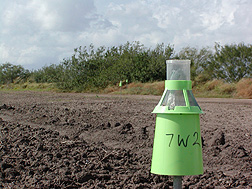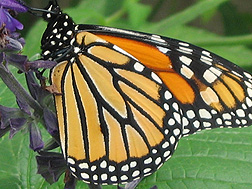Trapping Weevils and Saving Monarchs
Widely admired for its eye-catching wings and transcontinental migrations, the monarch butterfly, Danaus plexippus, depends on milkweed plants to survive. The monarch’s eastern population migrates each year between the Midwest and the mountains of central Mexico. Concern about loss of milkweed habitat has prompted conservationists to recommend milkweed plantings in yards and gardens so that monarchs can keep making their long-distance trips.
Now, an unexpected finding by Charles Suh and colleagues at the Agricultural Research Service’s Areawide Pest Management Research Unit in College Station, Texas, could help save milkweed habitat and preserve one of North America’s most admired insects. They have found a formula for a lure that can trap a major milkweed pest.
The discovery stems from research originally designed to help the Texas Boll Weevil Eradication Foundation (TBWEF), which uses traps to monitor and detect boll weevil populations. Captures of weevils in traps are also used to help eradication-program managers decide whether to spray insecticides against boll weevils in particular fields.
But the traps haven’t always been reliable for detecting incipient weevil populations. At some field locations, for example, no weevils were captured in traps, but substantial weevil infestations were later found in nearby fields.
|
|
In 2009, TBWEF asked Suh to investigate. Though the boll weevil pheromone has a specific ratio of four component chemicals, commercial lures are formulated with a different ratio of the four pheromone components because the lures are easier and less expensive to manufacture that way. Suh and ARS colleague John Westbrook asked the manufacturer to produce a lure that replicated the ratio of the natural components, and they compared that lure with the standard-blend lure in field trials in Mexico and South Texas.
In a field study, they set up 80 pairs of traps along county roads and highways in Atascosa and Frio counties in Texas, with each pair spaced at least 50 meters apart and traps within each pair spaced about 25 meters apart. They baited one trap in each pair with a lure containing the standard blend and baited the other with the experimental blend. Traps were checked once a week from mid-May to mid-June, and lures were replaced every other week.
In the first week, the researchers found that the traps were capturing a type of weevil distinctly different from the boll weevils they expected. The mysterious strangers were quickly identified as milkweed stem weevils, Rhyssomatus lineaticollis, a major pest of milkweed. They initially discounted the number of milkweed stem weevils being lured into the traps as irrelevant, but by the second week, it became obvious that more milkweed stem weevils were being captured than boll weevils and that the milkweed weevils were increasingly attracted to the experimental lure. The results showed that while the boll weevils were no more attracted to the experimental lures than to the standard lures, the milkweed weevils were more attracted. Overall, four times more milkweed weevils were captured in traps baited with experimental lures than in traps baited with standard lures.
The discovery, reported in Southwestern Entomologist, could be used to develop a trap-based system for detecting milkweed weevil and monitoring their dispersal and movements across landscapes, Suh says. Such a system could also help conserve a rare type of milkweed. The number of milkweed species attacked by the stem weevil includes Mead’s milkweed (Asclepias meadii), which is listed as a threatened species of plant (a risk level just below endangered) and is the focus of a federal recovery plan by the U.S. Fish and Wildlife Service.—By Dennis O'Brien, Agricultural Research Service Information Staff.
The research is part of Crop Protection and Quarantine, an ARS national program (#304) described at www.nps.ars.usda.gov.
Charles Suh is in the USDA-ARS Areawide Pest Management Research Unit, 2771 F&B Road, College Station, TX 77845; (969) 260-9588.
"Trapping Weevils and Saving Monarchs" was published in the October 2012 issue of Agricultural Research magazine.








